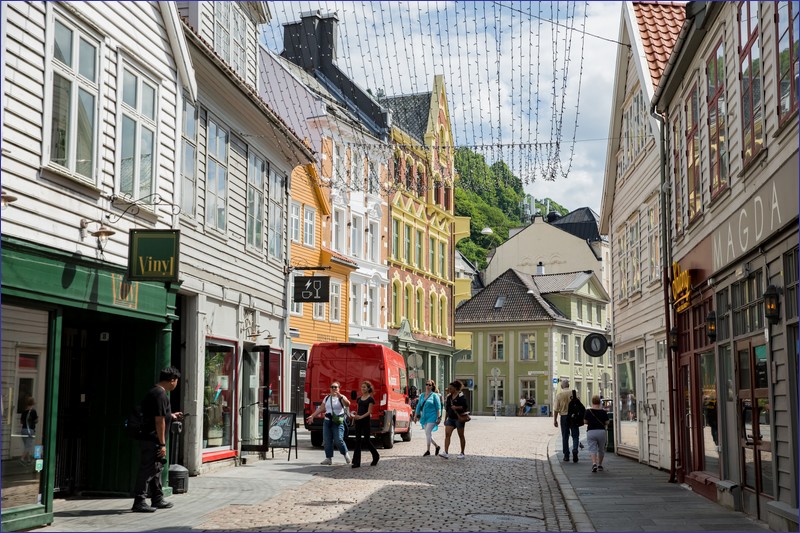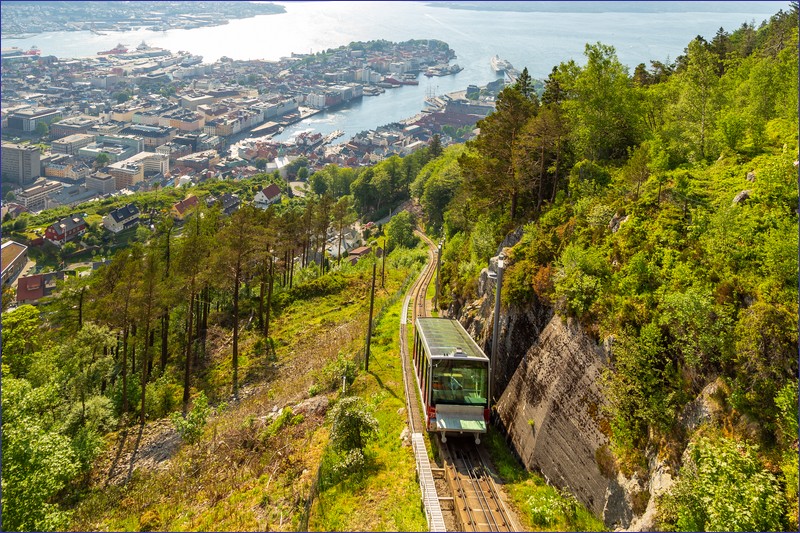Bergen was for centuries the most important city in Norway. Today, with a population of around 270,000, life in the city still revolves around the port. Although Bergen eventually lost the competition to Oslo as Norway’s primary administrative center, it is widely regarded as the cultural capital of the country, with cultural events taking place almost daily. The small fishing and trading settlement of Bjorgvin was founded by the then-King of Norway, Olaf III the Peaceful (1050–1093). The city is also known for its unfavorable weather—it rains here for much of the year. However, this doesn’t deter the many tourists who visit.
Main Sights and Attractions:
Bryggen District – A charming area located along the bay. This is where the first residents of Bergen settled. The district consists of historic merchant houses, built side by side along narrow, wooden-paved streets. The buildings face the waterfront. In the past, the Hanseatic League held a monopoly on the trade of fish and grain, and the merchants living in these houses were mostly of German origin. Profits from trade went into the hands of a small elite. To protect the houses from fires, a ban on open flames inside homes was imposed, which often led to deaths from hypothermia during harsh winters. The ban, however, didn’t save the district from disaster. In 1702, a fire destroyed almost all of Bryggen. Only a few houses survived, and some of the burned buildings were later rebuilt. The last major fire occurred in 1955. Today, visitors can see more than 60 wooden buildings standing side by side, evoking the Hanseatic era.

Torget Square – The central square of Bergen. For centuries, it has hosted the fish market. At the stalls, visitors can purchase fresh salmon, shrimp, crabs, reindeer meat sandwiches, and local handicrafts. The square has a unique atmosphere and is worth visiting, even if you’re not planning to shop.
Hanseatic Museum – A small museum located in a corner building by the harbor, presenting the life of Hanseatic merchants. Established in 1872, it is one of the oldest museums in Norway. The museum is housed in one of the oldest and best-preserved merchant houses in the Bryggen district. Inside, a merchant’s residence has been recreated, including a bedroom, servant and apprentice quarters, and a fish storage room.
Bergenhus Fortress – A large star-shaped fortress originally built in the 13th century and expanded until the 19th century. In the Middle Ages, it was known as Holmen; after coming under Danish rule, its name was changed to Bergenhus. Today, the fortress grounds serve as a public park and event space. In summer, outdoor concerts are held here. Within the fortress are two notable historic buildings:
Håkon’s Hall (Norwegian: Håkonshallen) – Built at the order of King Håkon Håkonsson between 1247–1261, this was the largest and most prestigious building in the former fortress during the Middle Ages. It was used as a warehouse from 1520 and was almost completely destroyed in 1944 by an explosion on a German ammunition ship. It was rebuilt after the war and now hosts concerts and guided tours.
Rosenkrantz Tower – A Renaissance structure from 1560 named after the Danish governor of Bergen, Erik Rosenkrantz (1519–1575). The tower served both defensive and residential functions. Today, it is open to the public as a viewpoint. Visitors can climb the spiral staircase to the top for panoramic views of Bergen’s historic district.
Bryggen Museum (Norwegian: Bryggens Museum) – Located in a modern building at 3 Dreggsallmenningen Street, the museum presents the history of the Bryggen district. Its most valuable exhibits include artifacts from archaeological excavations conducted between 1955 and 1969, as well as old tools and everyday items. The museum was built in 1976 on the foundations of one of the district’s oldest houses, dating back to the 12th century. These foundations can be viewed on the museum’s lower level.
Church of St. Mary (Norwegian: Mariakirken) – A Romanesque-Gothic church built from grey stone with two towers, constructed around 1180. It is the oldest preserved building in Bergen and the most beautiful Romanesque church in Norway. Over the centuries, it was repeatedly damaged by fires and rebuilt. The most valuable interior features include a pulpit donated by Hanseatic merchants in the 15th century and a gilded medieval triptych.
Gamlehaugen – The official royal residence in Bergen, located in the southern outskirts of the city. The palace was built in 1900 by the Norwegian architect Jens Zetlitz Monrad Kielland for the prominent politician and shipping magnate Christian Michelsen, who requested a Scottish-style castle surrounded by an English landscape park. The residence was built on the site of an abandoned old farm. Michelsen, who later became Norway’s Prime Minister, lived in the palace until his death in 1925. The building, later acquired by the Norwegian state, fell into disrepair but was renovated between 1989 and 1991.
Leprosy Museum (Norwegian: Lepramuseet) – an intriguing museum housed in an 18th-century building of St. George’s Hospital. Its permanent exhibitions focus on the history of leprosy in Norway and life in old hospitals. Visitors can explore the interiors and wards of the former leprosarium, as well as an exhibition dedicated to the scientific research conducted by Norwegian scientists on this disease. It’s worth noting that Norwegian doctor and scientist Gerhard Armauer Hansen (1841–1912) discovered the leprosy bacillus (Mycobacterium leprae) in 1873.
Gamle Bergen – an open-air museum located in Sandviken, 5 kilometers north of Bergen. The museum features more than 40 historic buildings from the 18th and 19th centuries, originally from Bergen and its surrounding areas. Visitors can explore a bakery, a dental office, and a general store, among other attractions. Craft demonstrations are held in the summer months.
Fløibanen – a funicular railway that carries tourists from the city center to the top of Mount Fløyen (320 meters above sea level), offering a beautiful panoramic view of Bergen and the bay. At the summit, there is a café and a souvenir shop. Numerous walking trails start near the upper station, winding through hills and lakes. The ride to the top takes 5–8 minutes. The lower station is just a 2-minute walk from the fish market. Along the way, the carriage stops at Fjellveien, where a scenic walking trail begins, and Skansemyren, located a 5-minute walk from a sports center.
Fløibanen was opened in 1918. It is electrically powered, and there is always a driver in the carriage. Each car can carry up to 120 passengers. The track is 848 meters long, the speed is 4 meters per second, and the rail gauge is 1000 mm. The new carriages were introduced in 2022.
Related articles:
Train travel in Norway – a comprehensive guide
